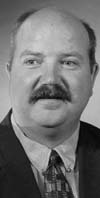
Surveys
DJC.COM
April 22, 2004
Keeping runoff out of sight, but still in mind
DietzHartlage Landscape Architecture

Dietz
|
Renovation of the playfields at the Kitsap County Special Events Center presented an opportunity to resolve a series of site and public use challenges associated with the county fair and the adjacent ballfields.
Every August since 1960, the Kitsap County Fair and Stampede has brought thousands of visitors to this 25-acre site east of Silverdale. Cowboys and their horse trailers would park on the ballfields for several days during the rodeo events.
The overflow parking for the rodeo arena, visitors, vendors and animal exhibitors is a 6-acre gravel lot to the south of the fairgrounds. While suitable for up to 600 cars, without striping the lot usually held just over 300 vehicles.
Roughly 60 percent of stormwater on the site came from off-site sources. It swamped the parking lot's lone catch basin, which led to an undersized detention pond. No oil-water separation capacity existed, and sediment-laden stormwater flowed unchecked through the small pond into nearby Barker Creek, a salmon-bearing stream.
To the south of the parking lot, the ballfields were nearing the end of their useful life. Areas not reached by the irrigation system left large yellow patches of turf in the summer. Winter soccer play made the ballfields soggy for spring usage due to soil compaction.
The restroom/concession building was also in dire need of replacement, accessibility issues needed to be addressed, and all the utilities needed upgrading.
The county was looking to create a facility suitable for a minor league team. In 2002, AHBL was hired by Kitsap County Parks to use a low-impact site development approach to develop a design consistent with LEED sustainable sites criteria.
Parking
We collaborated with landscape architect Dennis Oost, project manager for Kitsap County Parks, to develop a green parking solution that minimized the amount of asphalt paving. This paving encircled a green field of Grasspave that would handle seasonal parking for nearly 400 vehicles associated with the fair.
During the rest of the year, the Grasspave areas could be used for non-organized sports or pick-up games of soccer. Grasspave is made up of a series of recycled plastic rings connected by an interlocking geogrid structure that allows grass to grow while still being strong enough to drive and park on. It is installed below the surface, making it invisible from above.
To handle the off-site and on-site stormwater, the design called for a “treatment train” that would allow stormwater to be treated and re-used for irrigation. Runoff is collected through bioswales on either side of the Grasspave area and flows into a 1.6 million-gallon underground cistern.
The cistern, called Rainstore and made by Invisible Structures, was designed to provide flexibility for the client. The collected stormwater can be reused to irrigate the Grasspave parking lots and bioswales during the late spring to late fall period, and/or it can proceed to a sand filter system prior to final discharge off-site. When empty, the cistern can easily accommodate the run-off generated by a 100-year storm event.
Ballfields
Most new ballfields are designed with an under-drainage system to provide more year-round play. AHBL took this a step further by collecting all the water within another Rainstore cistern.
The water collected within the cistern will contain some excess fertilizers. By using this water for field irrigation, fertilizers that leech through to the field under-drainage system are re-applied, helping reduce the amount of fertilizers used each year. This allows Kitsap County Parks and Recreation to cut back on its water usage by an estimated 3.4 million gallons of potable water per year.
In the event of a 100-year storm, water that exceeds the capacity of this system drains to infiltration trenches around the ballfields and is eventually discharged downstream.
Landscape design
To minimize maintenance costs, AHBL's design keeps lawn areas to a minimum. The sand-based fields are planted with high-quality perennial ryegrass for playing durability.
Drought-tolerant native plantings create a windbreak for the site and add to the filtration properties of the bioswales. Columnar trees line the outfield fence of the baseball field to create a green wall natural backdrop.
We were very fortunate to work with a client who wanted to apply LEED site sustainability criteria to a project that does not fit within the current profile (i.e. no major buildings) for LEED certification. The concepts used in this project can be applied to other recreational facilities where low-impact site development is a major project goal.
Duane Dietz is a registered landscape architect and an associate principal at DietzHartlage Landscape Architecture, a division of AHBL.
Other Stories:
- Gardeners go trowel to trowel in contest
- Art meets Frisbees in north Seattle park
- What is your landscape telling you?
- Seattle's big chance to reconnect the waterfront
- Ecological restoration goes beyond trees and shrubs
- Amgen unwraps the landscape at Helix
- Landscape designers promote active lifestyles
- Low-allergen landscapes nothing to sneeze at
- The do's and don'ts of planting new trees
- Shared streets can provide open space, too
- Landscape connects rivers and cultures
Copyright ©2009 Seattle Daily Journal and DJC.COM.
Comments? Questions? Contact us.